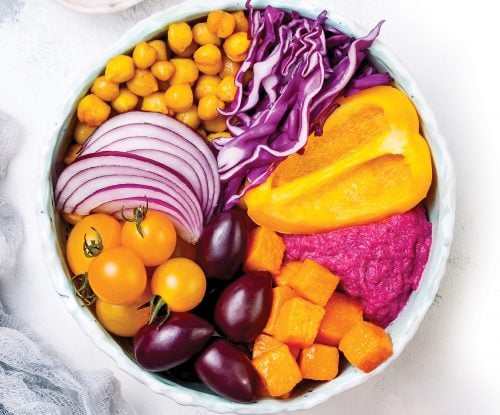
Eating a rainbow of coloured foods maximises the variety of nutrients in your diet. We reveal some specific health benefits of easy-to-find colourful fruit and veg.
Orange: Carrots
1 of your 5-plus a day: 1 medium carrot = 170kJ (41cal)
Star nutrient: Beta-carotene
This orange antioxidant pigment, found in carrots, is important for eye health and eating more of it has been linked with lower rates of glaucoma in women. One medium carrot provides enough beta-carotene (which we convert to vitamin A) to get 79 per cent of the daily suggested dietary target (SDT) for vitamin A for women, and 64 per cent for men.
Try them like this
- Grate into a homemade burger mix to add bulk and reduce kilojoules
- Cut into batons and dip into hummus
- Shred and combine with white cabbage, onion and low-fat plain yoghurt (perhaps with a dash of something hot) for a healthy coleslaw.
Yellow: Bananas
1 of your 5-plus a day: 1 medium fruit = 440kJ (105cal)
Star nutrient: Potassium
One medium banana provides 9 per cent of your SDT for potassium, which helps control the balance of fluids in the body. It also helps the heart muscle to work properly. The less ripe the banana, the lower its GI, meaning it raises blood sugars more slowly after eating.
Try them like this
- Add them to Banana, raspberry and walnut loaf.
Red and green: Apples
1 of your 5-plus a day: 1 medium apple = 320kJ (77cal)
Star nutrient: Quercetin
Regularly eating apples boosts antioxidant quercetin, which is linked to lower levels of C-reactive protein, a marker of inflammation linked to heart disease. A medium apple also has 3g fibre, some of which is cholesterol-lowering soluble fibre.
Try them like this
- Make Bircher muesli: Soak oats overnight in unsweetened almond milk with raisins, dried apricots and hazelnuts. Serve with grated apple and natural yoghurt.
White: Leeks
1 of your 5-plus a day: 3/4 cup chopped leek = 93kJ (22cal)
Star nutrients: Sulphurous compounds
Leeks contain a group of nutrients called organosulphur compounds. When leeks are cut, these compounds mix with amino acids forming new compounds that appear to have health-protecting effects, including lowering the risk of prostate cancer in men.
Try them like this
- Finely slice and add to stir-fries
- Chargrill and add to a courgette and herb salad
- Chop and sweat down as part of a risotto base.
Purple: Eggplant
1 of your 5-plus a day: 1 cup sliced eggplant = 64kJ (15cal)
Star nutrient: Nasunin
The skin of eggplants is rich in the purple pigment nasunin which, research suggests, helps to prevent tumour growth by halting the growth of new blood vessels that supply the tumour.
Try them like this
- Stuffed and baked: Halve an eggplant, scoop out the flesh and chop, then mix with cooked couscous, harissa paste, garlic, onions, dried apricots and chickpeas. Pile back into the skins, bake until hot, then serve with a crisp green salad.
Article sources and references
- Coleman AL et al. 2008. Glaucoma risk and the consumption of fruits and vegetables among older women in the study of osteoporotic fractures. American Journal of Opthalmology 145:1081-9https://www.ncbi.nlm.nih.gov/pubmed/18355790
- Hsing AW et al. 2002. Allium vegetables and risk of prostate cancer: A population-based study. Journal of the National Cancer Institute 94:1648-51https://www.ncbi.nlm.nih.gov/pubmed/12419792
- Matsubara K et al. 2005. Antiangiogenic activity of nasunin, an antioxidant anthocyanin, in eggplant peels. Journal of Agricultural and Food Chemistry 53:6272-5https://www.ncbi.nlm.nih.gov/pubmed/16076105
www.healthyfood.com










